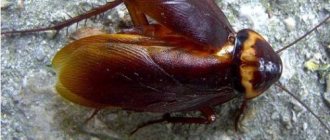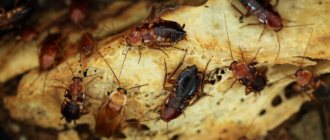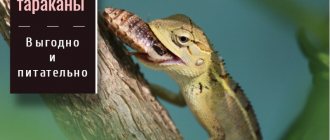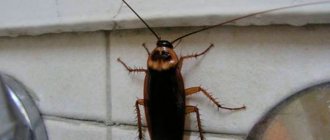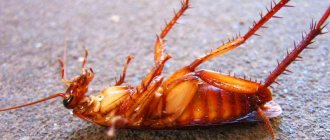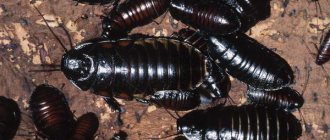External structure of cockroaches
The order “cockroaches” is quite numerous and numbers up to 7 and a half thousand species. In our territories, the most numerous is the red cockroach or Prusak, as it is also called. Black cockroaches are less numerous, with the American cockroach being a fairly rare species. The structure of cockroaches, despite their species, is almost identical, although they differ in size and color.
Interesting to know! The structure of modern cockroaches is practically no different from the structure of their ancient representatives of the order “cockroaches”, in the form of Ignaroblatta, which was found in fossils. Their size was 4 times larger than the Prussians, but at the same time they were smaller in size compared to modern giant cockroaches. Moreover, they were the most numerous representatives of this genus who lived within the ancient continent of Gondwana.
The structure of their body is considered quite perfect, so it is not surprising that these insects have retained all their basic qualities for many millions of years.
The cockroach has a flattened body, which allows it to penetrate through the narrowest cracks, while the body consists of 3 parts: head, chest and abdomen.
Scientific experiments
Finnish scientists decided to find out how insects are able to see so well in the dark. An experiment was conducted in which a test cockroach was placed on a trackball, and a rotating platform with alternating contrasting stripes was launched around it. During the experiment, the lighting either became too bright or turned off completely.
As a result, the experimental sample was able to navigate in pitch darkness, which proved the uniqueness of its faceted vision and ability to perceive the surrounding space in the absence of light sources. That is why these pests prefer a nocturnal lifestyle in order to be invisible to their enemies.
Head structure
The cockroach's head is triangular in shape, and it is covered on top by a shield connected to the first segment of the chest. Therefore, you can see that only the back of the head peeks out from under the shield, and the rest of the head looks down. On both sides of the head there are compound eyes consisting of 1800 fragments. As a result, the insect perceives all objects in the form of a mosaic made up of many colored pieces. The eyes of cockroaches are not designed for detailed study of objects, but at the same time, the color resolution of these insects is 5 times higher than that of humans.
Interesting fact! Thanks to the presence of compound eyes, the cockroach is able to detect individual movements that follow with a frequency of at least 300 Hz. Therefore, he is able to see the movement of an object in slow motion, which helps him timely dodge flying objects, such as a slipper, for example.
In addition to these, one might say, compound eyes, on the front of his head there are 2 simple eyes, the functions of which have not been studied to this day. Experts say that thanks to these simple eyes, the insect can navigate perfectly in the dark.
The cockroach's long whiskers serve as organs of touch, smell and temperature determination. The whiskers are distinguished by the fact that they have nerve shoots that constantly send signals to the pest’s central nervous system. With the help of their whiskers, insects contact each other, and they can transmit and perceive the necessary information. After each molt, the whiskers of individuals grow by 1 segment, so you can determine how old the cockroach is. An adult may have about 80 of them, but this does not mean that the cockroach is 80 years old. Only specialists can do the calculations.
The insect's oral apparatus has a rather interesting structure, since each part of it is designed to perform separate functions. For example:
- The upper lip (lambrum) has a movable connection with the head and on its inner surface there are receptors that signal the composition of food.
- With the help of the lower jaw (mandible), the insect firmly holds food. The lower jaws look like curved plates with sharp teeth.
- With the help of the upper jaws (maxillae), the insect chews, grinds and grinds food. They are located above the lower jaws and are armed with chemoreceptors.
- The lower lip (labium) covers the oral opening from below and consists of several parts. Thanks to the presence of this lip, food particles do not fall down. In addition, the lower lip has taste and tactile receptors that help find food and analyze its origin.
- In the cavity of the oral pharynx there is a salivary gland and something similar to a tongue, thanks to which cockroaches drink water.
It is believed that the oral apparatus of these insects has not undergone significant changes over such a long period of their existence.
10 facts about COCKROACHS that you are better off not knowing
What you didn't know but would like to know about the life of cockroaches
Do cockroaches eat bedbugs ? No, unfortunately, cockroaches ignore these pests. However, if there is insufficient food (if the population has grown too large), they can include bug eggs in their diet.
Do cockroaches have wings ? Yes, these arthropods have a couple of well-developed wings. Of course, they won’t fly, and they won’t be able to, but they will be able to plan effectively in case of danger.
Do mice eat cockroaches ? Yes, they do; these rodents are omnivores and have an excellent appetite.
Do battering rams have a brain Yes, even they have a brain located in their head. But these insects also have a group of nerve cells (ganglia) scattered throughout the body that control motor and signaling functions - which is why a headless cockroach can survive for some time.
Do spiders eat cockroaches Of course, the whiskered insect can be an excellent source of building protein.
Do cats eat cockroaches?
Most often, domestic furries are disdainful of dining on these arthropods, but if they wish, they can also profit from them. This situation is complicated by the fact that cockroaches are carriers of many dangerous diseases, and a cat that eats an infected insect runs the risk of getting sick.
Can cockroaches live in a refrigerator?
The conditions in the freezer are simply unbearable for them, but in the refrigerator compartment, where +5C is maintained, insects can feel quite comfortable.
Do cockroaches have blood?
Yes, these insects have blood, but it is white. Cockroaches have an open circulatory system, with organs washed by blood and no small blood vessels.
What animal eats cockroaches ? The hedgehog is a fan of cockroaches; he feasts on them, supplying his body with protein.
The thoracic region and the purpose of the paws
On the thoracic part of the cockroach's body there are wings with elytra, as well as insect legs. Cockroaches, like any representative of the “insect” class, have 6 legs, that is, 3 pairs. Each tarsus is located on one of the thoracic segments and represents:
- Prothoracic legs, which have the shortest length and serve as “brakes” if the insect moves too quickly.
- Medium-thoracic paws that can move in any direction, providing the insect with high maneuverability.
- The metathoracic legs are designed to move the insect only forward. They are the longest in size.
The cockroach's paw is a rather complex mechanism, which includes 5 segments. The thighs, flattened in shape, are armed with spines below. The first 4 segments are armed with pads, and the fifth with claws with a suction cup located in the center. This allows the insect to crawl on both horizontal and vertical surfaces.
Interesting fact! Having relatively long legs helps the cockroach not only run fast, but also jump high. In addition, with the help of all 3 pairs of limbs, the cockroach takes care of itself from the head to the abdomen.
In other words, the insect uses 3 pairs of its legs for its intended purpose. Cockroaches are able to move along the surface at a speed of about 4 kilometers per hour. If a cockroach grew to the size of a cheetah, it could easily outrun it. With the help of sensitive hairs located on the legs, the cockroach assesses the situation around itself. In 1 minute he is able to change his trajectory up to 30 times.
Here, on the thoracic region, the wings with more rigid elytra are attached. Using the length of the wings, you can determine the gender of individuals: females have much shorter wings. These insects use their wings during the mating season, as well as when moving or falling. By spreading their wings, individuals demonstrate their readiness to mate. Despite the presence of wings, cockroaches cannot fly, although there is one species that lives in South and Central America that can fly.
Abdomen: structural features
A maximum of 9 abdominal segments can be distinguished, although it actually consists of 11 segments. The anus is located on the tenth segment, and the last segment is formed by paired outgrowths that have no purpose, but represent a separate sign of a certain type of cockroach. These growths have been preserved for millions of years, indicating their relict origin.
The female has a special capsule (ootheca) at the end of her abdomen, which contains 12-16 eggs and subsequently develops into the hatched larvae. Under favorable conditions (availability of water and food), this capsule appears in the female every couple of days.
Interesting to know! During the process of growth and development, not only the size of individuals changes, but also their weight, which at the beginning of development is about 2 mg, and at the end of the process about 8 mg. The larvae, in comparison with the imago, do not have wings, cerci and spines on their legs, but have short antennae. After the fifth molt, the insects develop genitals and complete external resemblance to adult cockroaches.
According to University of Massachusetts professor J. Kunkel, cockroaches are endowed with basic driving instincts, such as hunger, thirst, survival and reproduction. In order to understand whether cockroaches have a brain, you should study its internal structure.
Report No. 2
One of the many representatives of the insect order are cockroaches. Scientists have counted more than 7,500 species of cockroaches. Traces of the ancient ancestors of cockroaches have been found more than 400 million years ago.
The body of the insect is oval, flat, the length of which in some species reaches up to 10 cm. The head of the cockroach is a flat triangular (sometimes heart-shaped) shape, protected by a shield-shaped front back. The downward-facing mouth has chitinous teeth and strong jaws. The eyes of cockroaches are large, consisting of two simple ocelli. Insects have mosaic vision; they do not see whole pictures. However, they see and react to flickering light better than humans. In some species the eyes are atrophied, and there are species without them (cave species).
Particularly sensitive are the insect's antennae, the length of which exceeds the length of the cockroach's body and are covered with many micro bristles. For them it is an organ of smell and touch. At their tips are nerve endings that send impulses to the brain. With transparent edges, the insect's large foredorsum is flat in shape.
The insect is a six-legged animal that runs well. Each pair of legs plays an important role in the process of movement: the front (shortest) - brakes, the middle - provide the ability to move in different directions, the rear (longest) - for moving the body forward. The speed of a cockroach can be more than 70 cm per second. 25 times per second, a cockroach can change direction when running, which allows it to escape death. Biologists have proven that the cockroach’s body continues to function in the absence of its head for a long time and the insect only dies of starvation.
Mobile insects of the order of cockroaches love moisture and warmth. Most representatives of cockroaches have a nocturnal lifestyle; during the day they hide under the crowns of trees, in animal burrows, and under leaves. Cockroaches feed on leftover food and any organic matter (paper, fabrics, book bindings). The favorite food of cockroaches is bread, flour products, cereals. This type of insect is very hardy because it can go without food for up to a month. A female can eat up to 50g per day. The male eats half as much food.
The fertility of cockroaches is surprising; with a life expectancy of about six months, the female lays up to 40 eggs at a time, during her life she does this about 7 times (on average, she gives birth to more than 300 cockroaches). This complicates the fight against insects, and it is simply necessary to fight them in people’s homes, since they are carriers of infections and helminths.
The amazing ability of the cockroaches to resist radiation. They are able to survive in conditions exceeding 10 times the lethal dose of radiation for humans. This allows the ability of slow cell division in the body. Scientists have proven that cockroaches can survive the explosion of an atomic bomb.
With the exception of Antarctica, cockroaches are found on all continents. Most species and subspecies of cockroaches inhabit the subtropics and tropics. Despite their fertility and adaptability to any conditions, insects have enemies. They are food for hedgehogs, cats, lizards, frogs, and spiders. Dead cockroaches are a treat for ants.
Structure, sensory organs, 7th grade biology, for children
Internal organs of a cockroach
According to some claims, a headless cockroach can live for several days. Such possibilities are associated with the structure of the nervous system and other organs, which allows the cockroach to live without a head.
Structure of the nervous system
The central nervous system of the cockroach is formed by 11 independent nerve ganglia. In the head of an insect there are only 2, but large, nerve nodes. They are located under and above the pharynx, and are responsible for the actions of the eyes, whiskers and probes located on the lips of the cockroach.
3 thoracic nodes, together with the subpharyngeal node, control the operation of the oral apparatus, wings, paws and head muscles, as well as the muscles of the thoracic region.
In the belly of the insect there are six small nerve ganglia, the largest of which is the terminal one, which is responsible for the functions of the genital organs and sensitive cerci.
Important point! The internal structure of the cockroach is such that it can easily do without a head, especially since its breathing is not connected to the nerve nodes located in the head. There is no pressure in his circulatory system, so he does not bleed. At the same time, he does not waste energy while being immobile, so he can easily do without food. Under certain conditions, it can live without a head for up to 1 month.
The nerve fibers of a cockroach are connected to all organs of the insect, including the sense organs. The cockroach not only has unique vision, it also has excellent hearing. The insect's auditory receptors are located near the anus.
Circulatory system
The circulatory system is of an open type, while the cockroach’s blood is white and washes all internal organs, being in free circulation. The cockroach's heart is a tubular organ located in the dorsal pericardium. The middle sinus contains the intestines, and the thoracic sinus contains the nerve cord.
Due to the work of the tubular organ, hemolymph (blood) is pumped through the circulatory system. The work of the heart is carried out due to pressure differences resulting from the work of the muscles. Blood is pumped slowly, so cockroaches are quite sensitive to changes in ambient temperature.
Respiratory system
On both sides of the abdomen there are tiny holes called spiracles, through which the insect breathes. There are 10 pairs of them, which means that on each side of the abdomen there are 10 such spiracles. From these holes extends a whole system of tubes - tracheoles, which ultimately connect with 3 pairs of several large tracheal trunks. Oxygen reaches all organs by diffusion.
Important fact! Cockroaches are able to hold their breath for up to 40 minutes, blocking their spiracles, which allows the insect to survive in difficult living conditions.
As a rule, a cockroach, being stationary, expends practically no energy. It is believed that they are in a state of movement for only 25% of their lives, so cockroaches are also considered the laziest insects.
Digestive system
When food enters the cockroach’s mouth, it is moistened with saliva (previously crushed) and enters the goiter through the esophagus, after which it is sent to the gizzard. Therefore, the process of digestion of food begins in the crop and ends in the stomach. After this, the food enters the intestine, which consists of the foregut and hindgut.
Interesting moment! The foregut consists of several parts. Immediately behind the mouth opening there is a buccal chamber with 6 teeth. With their help, the insect additionally crushes the food that has entered the mouth.
In the intestines of a cockroach there is a full range of bacteria and fungi that help the insect digest food objects, including even inedible food of inorganic origin.
Feces and urine are released through one anus. Urine is collected using special channels. They collect toxins dissolved in water throughout the body and send them to the anus.
Reproductive system
Males have a rather complex reproductive system. For example:
- The testes are located in segments 4-6 of the abdomen.
- The reproductive system includes the fungal (utricular) gland.
- The seminal vesicles empty into this gland.
- There are also organs of copulation.
- The female reproductive system is no less complex and consists of:
- From the ovaries, 8 avarioles each.
- From a pair of oviducts that are connected to the vagina.
- From the genital chamber where eggs accumulate. And collateral glands are associated with this chamber, which secrete a special secretion for the formation of a capsule (ootheca).
- From the ovipositor.
After fertilization, a capsule is formed into which the fertilized eggs enter.
Important point! The human cell nucleus includes 46 chromosomes, which are responsible for the transmission of hereditary information. Cockroaches have as many as 48 of them, although this is in no way evidence of the unique complexity of their body. Similar (relict) species of insects are distinguished by a large number of chromosomes.
According to scientists, cockroaches are more primitive, but the presence of 2 extra chromosomes indicates that the insects are quite resistant to external manifestations. It was this factor that turned out to be fundamental, ensuring the survival of the species for millions of years.
Does a cockroach have a heart and brains?
There are, and they are very reliable and harmoniously arranged. It is interesting that, based on the cockroach heart, American scientists made an artificial pump that moves blood throughout the human body. organ consists of as many as 13 chambers . Moreover, if one of them refuses, then nothing bad will happen.
In the case of a person, the failure of even one camera entails a quick and rather painful death. Thus, even a direct bite from a competitor in the heart does not always entail the death of the insect, although it still cannot without this organ .
Another thing is the brain . A cockroach can live quietly without it for several days . The reason for such vitality is that the organ only a supporting role for these insects . It coordinates cockroach movements and analyzes some information about the outside world.
Moreover, these functions also belong to clusters of nerves scattered throughout the body. That is, if a cockroach’s head is torn off, it will be able to run, jump and even skillfully avoid obstacles. By the way, he will also be able to breathe. And he will die not from the loss of his “upper limb,” but from thirst (this will happen in about 10 days).

